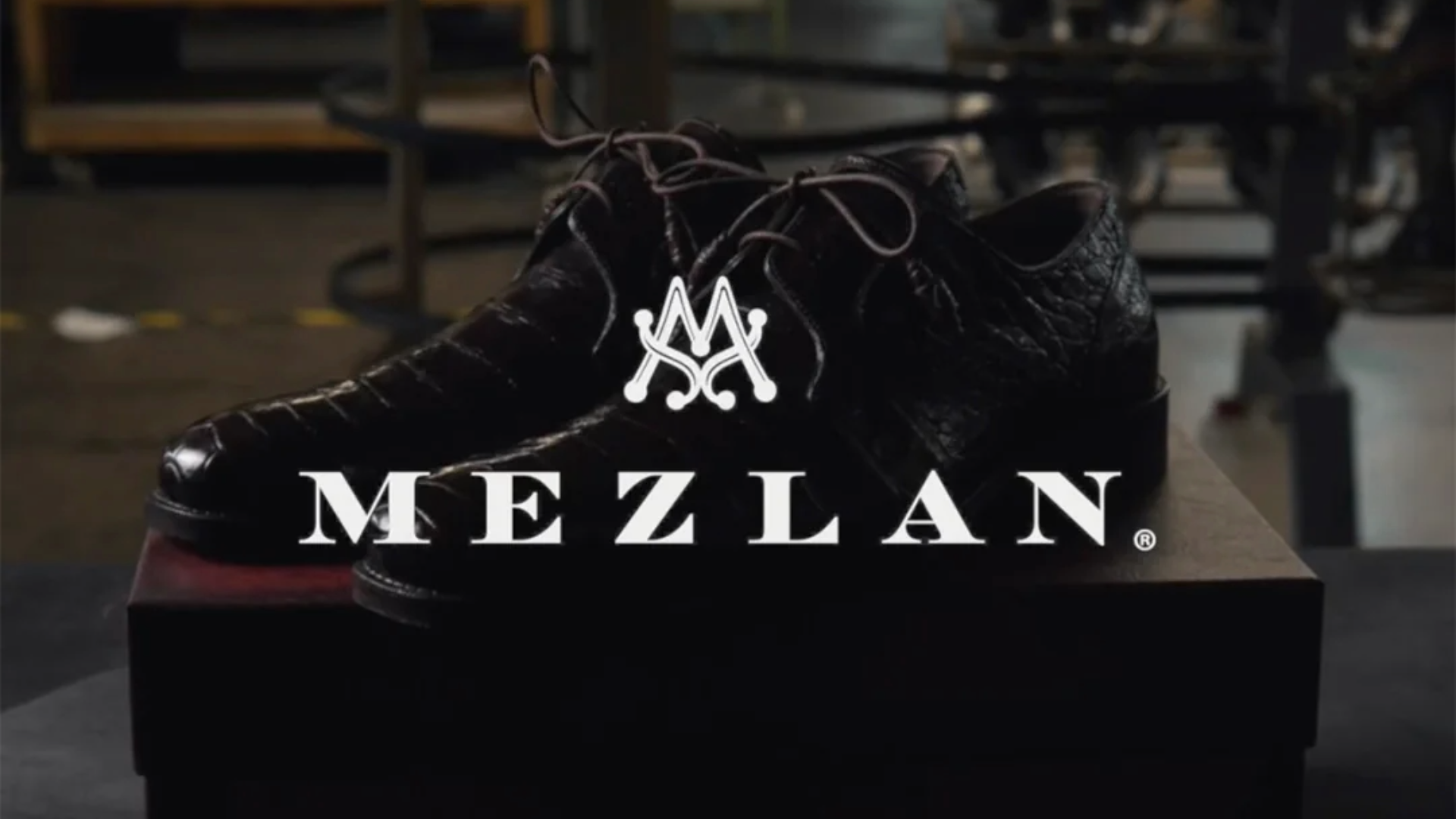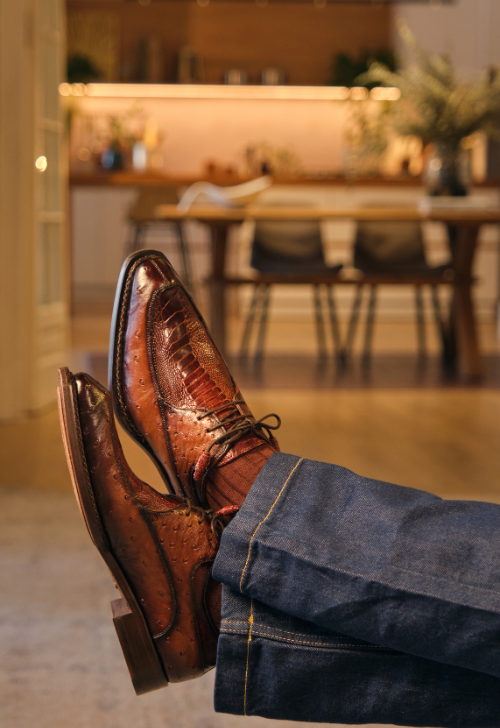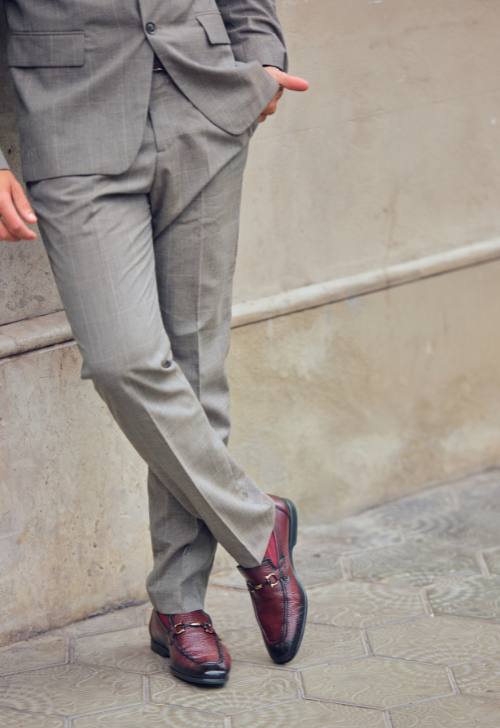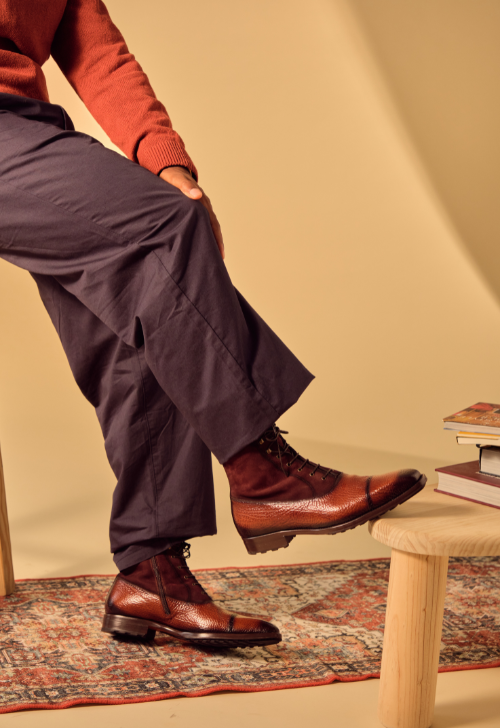When looking for a new pair of
men's designer shoes, it is common to see the names of different types of shoe construction bandied about. It is usually considered a given that shoe shoppers know what these methods are. That is not always the case, though. To that end, we are going to take a look at some of the most common shoe construction methods.
Goodyear Welting

When discussing Goodyear welting, we need to first be clear about the four major parts of a shoe. They are:
-
The Upper. This is the part of the shoe that forms the elements usually seen when wearing a shoe. It encompasses the design of the shoe, as well as the lacing.
-
The Insole. This is the piece of leather along the bottom of the shoe that touches the foot.
-
The Outsole. This is the piece of leather along the bottom of the shoe that comes in contact with the ground.
-
The Welt. This is the strip of leather that goes around the perimeter of the aforementioned outsole.
Getting the insole ready for stitching is the initial step in Goodyear welting. To do this, a shoemaker creates a rib that runs perpendicular to the face of the insole. This is where the twine is stitched. It sounds like a pretty straightforward task, but there are actually three different ways to accomplish this. First, a shoemaker can create the rib by hand-carving it from the face of the insole. A second option is to cut into the edge of the insole and turn it back to create the rib. The third option is to simply craft a rib from linen tape and glue it (gem it) to the insole. This gemming process often gets second looks, as it has the potential to be a substandard technique. In reality, it comes down to the shoemaker. When done correctly, gemming can create a secure and enduring rib. Lasting the shoe is the second step in Goodyear welting. This is when the upper (along with the its lining) is pulled over (and secured to) the last, as well as the insole. Depending upon the shoemaker, lasting can be done by hand or by a machine. It is most commonly done by a machine, though. Next comes the third step: the welting. This is where the shoemaker sews twine through the welt strip, upper, and insole rib. The shoemaker uses a lockstitch for this process to ensure that, if one stitch happens to come undone, all of the other stitching doesn't unravel. Then, one more row of lockstitching is used to connect the outsole to the other side of the welt. The lockstitching can be done either by hand or with a Goodyear welting machine, which was developed by Charles Goodyear. Invented in the 19th century, the Goodyear welting machine reduced the time it took to do the welting by hand from hours down to minutes. That said, actually running a Goodyear welting machine takes good degree of skill, as well.
Blake Construction
Blake construction is a staple of Italian shoemaking. Of course Italian shoemakers use a variety of different shoe construction techniques-in terms of high-quality shoes-but it is likely that more of them are created using Blake construction than the whole lot of other shoe construction techniques combined. One reason for its popularity is that it is quite simply an easier technique than Goodyear welting. Blake construction features just a single row of stitching to attach the insole to the upper and outsole. Because the stitching is on the inside of the shoe, though, it's impossible for a shoe featuring Blake construction to be sewn by hand. In fact, Blake construction was named after Lyman Reed Blake, the American inventor who, in 1865, patented the machine that does this stitching.
(In an interesting twist, Blake actually sold the patent for the machine to Gordon McKay and now Blake construction is sometimes also known as McKay construction.) So, why Blake construction? Frankly, Blake construction has a couple of noticeable advantages. The first advantage comes from there not being any stitching on the sole edges outside the shoe. This makes it possible to get really close-cut soles; more so that what is possible with a Goodyear welt. The second advantage-and this is really a matter of taste-is that since shoes using Blake construction have fewer layers in the sole, they are more flexible than shoes using Goodyear welting. There are also disadvantages to Blake construction, to be sure. They all come from the stitching along the insole. This stitching can bother some feet, particularly if not covered with a sock liner. Beyond that, there can be a wicking effect that pulls moisture from the ground to the inside of the shoe, which presents its own issues. For that reason, shoes featuring Blake construction are less waterproof than shoes that employ Goodyear welting, unless the former uses rubber soles.
Blake/Rapid Construction
As you might infer from the name, Blake/Rapid construction is similar Blake construction. Shoes using Blake/Rapid construction sport a row of Blake stitching along the insole. Rather than attaching the insole to the outsole, however, it attaches the insole to a midsole. The midsole is then fastened to the outsole via a row of stitching running along the outside of the shoe. This is the "Rapid" part of the construction. Blake/Rapid construction can be seen as a sort of hybrid between Blake construction and Goodyear welting. Blake/Rapid construction avoids the moisture wicking problem of traditional Blake construction because the stitching doesn't extend all the way from the interior of the sole to the outsole. The benefit of the improved waterproofing does have a flipside, however. Blake/Rapid shoes aren't as flexible as Blake-constructed shoes, nor do they have soles that are as close-cut. This is because of the row of stitching on the outside of the shoe that attaches the midsole to the outsole. One other aspect worth noting about shoes with Blake/Rapid is that they tend to look more "rugged" than similar shows featuring Blake construction. Whether you see this as a benefit or a detriment is simply a matter of preference.
Bologna Construction
At first glance, Bologna construction certainly bears a resemblance to Blake construction. This mainly stems from the row of stitching that goes from the inside of the shoe through to the outsole. In actuality, these two methods of shoe construction vary quite a bit. Because the leather forming on the upper of a Bologna construction shoe goes all the way around the shoe and is sewn into a bag or a tube, it is sometimes called tubular construction or bag construction. The upper part of the leather is lined with a normal lining leather. On a finished shoe, the part where the foot will rest along the lower part of the leather is lined with a soft leather insole. This type of insole is much less bulky than the insole you'd find in a shoe that sports Goodyear welting or Blake construction methods. A row of stitching on the underside of the upper lining and insole connects the two. As a result, upon inspecting the interior of a Bologna shoe, you'll notice a visible trench. A benefit of a shoe with Bologna construction, as we remember with Blake construction, is that the sole can be close-cut, which some people prefer. This, in combination with a less stout insole, leads to a very flexible shoe, which is by design. The goal of a Bologna construction shoe is to have an almost slipper-like feel. The flipside of that, however, is that Bologna construction shoes don't offer the same level of support or durability that you'll get with Goodyear, Blake, or Blake/Rapid shoes. In addition, Bologna constructed shoes also have the same moisture-wicking issue that Blake shoes do, as they also feature a row of stitching that goes from the inside of the shoe through the outsole.
Norwegian (Norvegese) Construction
While Norwegian construction was initially created to better waterproof shoes, today it is mainly appreciated for its looks and because it showcases some pretty technical shoemaking chops. Let's break it down. In Goodyear welting, the leather for the upper runs parallel to the ridge in the insole (the "feather"). The leather for the upper, the feather, and the welt are then all stitched together. In contrast, with Norwegian construction, the upper is turned outward so that it sits on top of, and parallel to, the outsole. Then, the feather of the insole and the outsole are brought together with two rows of stitching. As mentioned above, shoes featuring a Goodyear welt are better waterproofed than those featuring Blake, Blake/Rapid, or Bologna construction. This is because Goodyear welted shoes feature a channel that doesn't lead inside the shoe. Norwegian construction goes even further by also turning out the upper. Employing this technique, rather than running it parallel to the feather prevents any kind of channel at all. No channel = no water in the shoe.
Wrap Up
The look of your
shoes is just one element. By knowing the different methods of constructing a shoe, you can spend less time finding the one that carries the attributes you most desire.








Leave a comment